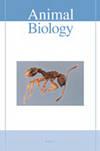Mouthparts of the crab Goniopsis cruentata (Latreille, 1803) (Decapoda, Brachyura, Grapsidae): morphological variations associated with environment, sex and stage of development
IF 0.9
4区 生物学
Q2 ZOOLOGY
引用次数: 0
Abstract
Abstract Individuals and populations can display variations in distinct aspects of their life histories, which could be reflected in their morphological characteristics. This study analyzed the mouthpart morphology of the crab Goniopsis cruentata in relation to environment, sex and stage of development. Our results indicate differences in the number of setae between developmental stages and environments, as well as the interaction between developmental stages and environments. There were no differences in setae types between stages, sexes or environments. There were differences in the shape of the ischium between adults and juveniles, with a more homogeneous ischium in juveniles than adults. We also found differences in food content between developmental stages, as well as an interaction between developmental stages and environment. Our results support an association between diet and morphology of mouthparts in G. cruentata , and that these apparatuses vary according to ontogenetic development and the environmental conditions that species are exposed to. These associations should be considered in studies that use these characteristics to verify morphological responses to environmental variations.角蟹口器(Latreille, 1803)(十足目,短尾目,蟹科):与环境、性别和发育阶段有关的形态变异
个体和种群在其生活史的不同方面表现出差异,这可以反映在它们的形态特征上。本文分析了黄角蟹口器形态与环境、性别和发育阶段的关系。研究结果表明,不同发育阶段和环境对刚毛数量的影响存在差异,同时也表明发育阶段和环境之间存在相互作用。在不同的阶段、性别或环境中,刚毛类型没有差异。成虫和幼虫坐骨的形状存在差异,幼虫的坐骨比成虫更均匀。我们还发现了发育阶段之间食物含量的差异,以及发育阶段和环境之间的相互作用。我们的研究结果支持食性和口器形态之间的联系,并且这些器具根据物种的个体发育和所暴露的环境条件而变化。在使用这些特征来验证对环境变化的形态反应的研究中,应该考虑到这些关联。
本文章由计算机程序翻译,如有差异,请以英文原文为准。
求助全文
约1分钟内获得全文
求助全文
来源期刊

Animal Biology
生物-动物学
CiteScore
2.10
自引率
0.00%
发文量
34
审稿时长
3 months
期刊介绍:
Animal Biology publishes high quality papers and focuses on integration of the various disciplines within the broad field of zoology. These disciplines include behaviour, developmental biology, ecology, endocrinology, evolutionary biology, genomics, morphology, neurobiology, physiology, systematics and theoretical biology. Purely descriptive papers will not be considered for publication.
Animal Biology is the official journal of the Royal Dutch Zoological Society since its foundation in 1872. The journal was initially called Archives Néerlandaises de Zoologie, which was changed in 1952 to Netherlands Journal of Zoology, the current name was established in 2003.
 求助内容:
求助内容: 应助结果提醒方式:
应助结果提醒方式:


